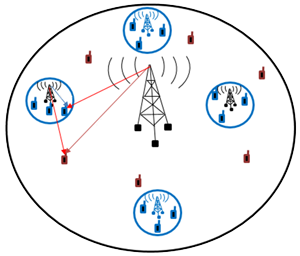Analysis of massive MIMO and small сells based 5G сellular networks: Simulative approach
DOI:
https://doi.org/10.3103/S0735272722060024Keywords:
sub 6 GHz, small cells, massive MIMO, mmWave, throughput, energy-efficiencyAbstract
Over the last decade, mostly in the urban areas, there is tremendous growth in the cellular traffic. Major concerns for cellular network operators nowadays is to deal with ever changing heterogeneity of users and high specification devices. Amidst upcoming technologies, this work illustrates both Massive MIMO (Multiple Input Multiple Output) based and Small Cells based cellular networks with both large and small-scale fading environment for signal propagation. The Massive MIMO set up network is analyzed with N-antennas at centered macro BS (Base station) offering services to U-users at an instant in the MC is analyzed with sub-6 GHz spectrums. The massive MIMO network is demonstrated with 8 x 8, 16 x 16, 25 x 25, 50 x 50, and 100 x 100 configurations. The Small Cells based cellular network is analyzed with 1-MC and 8-SCs by increasing the number of serving users from 50 to 100. The set up network is analyzed with allocation of sub 6 GHz at MC and mmWave spectrum at deployed SCs. The key performance metrics of the set up networks such as Sumrate, Average User Throughput, and Energy-efficiency are evaluated. With massive MIMO set ups, the plotted result depicts boost in the network sumrate and energy-efficiency with increase in the number of antennas at the centered deployed BS and users in the cell. The SCs based set up also depicts boost in the network sumrate and energy-efficiency with increase in the number of users in the MC serving with same number of SCs (8-SCs).
References
D. Tse, P. Viswanath, Fundamentals of Wireless Communication. Cambridge University Press, 2005, doi: https://doi.org/10.1017/CBO9780511807213.
J. G. Andrews, “Seven ways that HetNets are a cellular paradigm shift,” IEEE Commun. Mag., vol. 51, no. 3, pp. 136–144, 2013, doi: https://doi.org/10.1109/MCOM.2013.6476878.
M. Hughes, V. M. Jovanovic, “Small cells - effective capacity relief option for heterogeneous networks,” in 2012 IEEE Vehicular Technology Conference (VTC Fall), 2012, pp. 1–6, doi: https://doi.org/10.1109/VTCFall.2012.6399245.
A. Damnjanovic et al., “A survey on 3GPP heterogeneous networks,” IEEE Wirel. Commun., vol. 18, no. 3, pp. 10–21, 2011, doi: https://doi.org/10.1109/MWC.2011.5876496.
A. Anpalagan, M. Bennis, R. Vannithamby, Design and Deployment of Small Cell Networks. Cambridge University Press, 2015, doi: https://doi.org/10.1017/CBO9781107297333.
H. Claussen, D. López-Pérez, L. Ho, R. Razavi, S. Kucera, Small Cell Networks: Deployment, Management, and Optimization. Hoboken, NJ, USA: John Wiley & Sons, Inc., 2017, doi: https://doi.org/10.1002/9781119307600.
T. Q. S. Quek, G. De, I. Guvenc, M. Kountouris, Small Cell Networks. Cambridge: Cambridge University Press, 2013, doi: https://doi.org/10.1017/CBO9781139061421.
N. E, X. Chu, J. Zhang, “Small‐cell deployment over existing heterogeneous networks,” Electron. Lett., vol. 52, no. 3, pp. 241–243, 2016, doi: https://doi.org/10.1049/el.2015.2405.
A. J. Mahbas, H. Zhu, J. Wang, “Impact of small cells overlapping on mobility management,” IEEE Trans. Wirel. Commun., vol. 18, no. 2, pp. 1054–1068, 2019, doi: https://doi.org/10.1109/TWC.2018.2889465.
Y. Sui, J. Vihriala, A. Papadogiannis, M. Sternad, W. Yang, T. Svensson, “Moving cells: a promising solution to boost performance for vehicular users,” IEEE Commun. Mag., vol. 51, no. 6, pp. 62–68, 2013, doi: https://doi.org/10.1109/MCOM.2013.6525596.
F. Mohammadnia, C. Vitale, M. Fiore, V. Mancuso, M. A. Marsan, “Mobile small cells for adaptive RAN densification: preliminary throughput results,” in 2019 IEEE Wireless Communications and Networking Conference (WCNC), 2019, pp. 1–7, doi: https://doi.org/10.1109/WCNC.2019.8885444.
B. Błaszczyszyn, M. Haenggi, P. Keeler, S. Mukherjee, Stochastic Geometry Analysis of Cellular Networks. Cambridge University Press, 2018, doi: https://doi.org/10.1017/9781316677339.
H. ElSawy, A. Sultan-Salem, M.-S. Alouini, M. Z. Win, “Modeling and analysis of cellular networks using stochastic geometry: a tutorial,” IEEE Commun. Surv. Tutorials, vol. 19, no. 1, pp. 167–203, 2017, doi: https://doi.org/10.1109/COMST.2016.2624939.
J. Borah, J. Bora, “Energy-efficient ICI mitigation with dynamic and location-based power allocation in mobility-based 5G HetCN,” Wirel. Pers. Commun., vol. 117, no. 2, pp. 1441–1457, 2021, doi: https://doi.org/10.1007/s11277-020-07930-x.
J. Borah, J. Bora, “Dynamic and location-based power allocation mechanism for inter-cell interference mitigation in 5G heterogeneous cellular network,” Int. J. Commun. Syst., vol. 33, no. 15, 2020, doi: https://doi.org/10.1002/dac.4548.
J. Borah, M. A. Hussain, J. Bora, “Dynamic and energy-efficient ICI mitigation techniques for mobility-based 5G HetCN,” IET Commun., vol. 14, no. 9, pp. 1397–1403, 2020, doi: https://doi.org/10.1049/iet-com.2019.0898.
Y. A. Zakaria, E. K. I. Hamad, A. S. Abd Elhamid, K. M. El-Khatib, “Propagation measurements and calculation of path loss exponent for outdoor cellular communication systems at 3.5 GHz,” Radioelectron. Commun. Syst., vol. 64, no. 5, pp. 247–254, 2021, doi: https://doi.org/10.3103/S0735272721050034.


